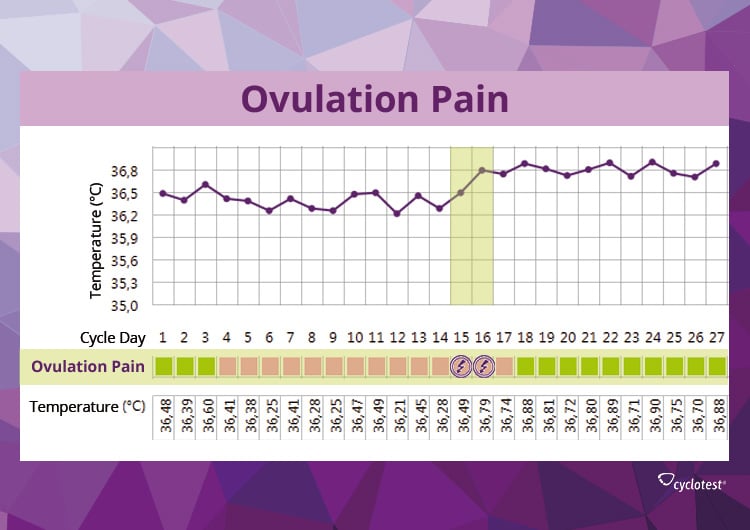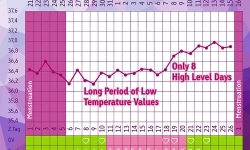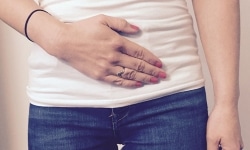Was Du auf dieser Seite findest:
What Are the Symptoms?
The sensation of ovulation pain is a twinge in the lower abdomen and it can last from one to several days. You might also feel a dragging pain or cramps, which can last for a few seconds or a few hours on either the left or right side of your belly.2 Some women do not feel anything during ovulation, others suffer from severe abdominal pain.
The way women feel ovulation pain varies. Usually, it is located either clearly on the left side or on the right side of the lower abdomen, depending on which ovary is releasing the egg during that cycle. This can vary every month. There might also be months without any symptoms.3 Some women also suffer from radiating back and leg pain as well as a feeling of pressure in the perineum.4
When Does Ovulation Pain Happen?
The symptoms occur around ovulation, i.e. up to a few days before or right after it. Most women can feel it one day before they are ovulating. When asscociating the pain with Natural Family Planning as a sign of fertility, it presumably happens about 2 days before the basal body temperature rises.5 Some women also notice a small amount of vaginal bleeding.6
Why Does Mittelschmerz Happen?
The exact cause of ovulation pain is not known. Scientists found the following possible causes:
- Spasms of the fallopian tubes or uterus as ovulation approaches while the follicle is growing. Each follicle carries an egg.7
- The rupture of the follicle releasing the egg might also be the cause.8
- An irritation of the abdominal cavity during ovulation could cause pain, too.1
Ovulation Pain as a Reliable Symptom?
You might wonder whether you can rely on ovulation pain as a symptom to determine the time of ovulation. In combination with primary symptoms like the basal body temperature and the cervical mucus, abdominal cramps during ovulation can actually help when you are planning to have a baby or for natural contraception.
Is it a Reliable Signal to Determine Ovulation?
You should not rely on intermenstrual pain as a method to identify ovulation. There is no reliable connection between the time of ovulation and abdominal pain in the middle of the cycle and each woman feels it in a different way. Thus, it is not possible to exactly determine a point in time, only a rough prediction can be made.1
Does it Signal my Fertile Days?
Mittelschmerz can be helpful to identify the highly fertile days. Especially when you are trying to get pregnant, since the chances of conceiving during that phase are particularly high.
However, abdominal cramps of this kind are not a safe signal for contraception because the point of time as well as the intensity can vary. Besides, not all women do have ovulation pain every month. Together with the method of Natural Family Planning, it can underpin the analysis, whether you are trying for a baby or would like to prevent a pregnancy.5
If you wish to identify your fertile phase naturally, the fertility monitor cyclotest myWay can support you. You can not only enter primary symptoms but also other relevant data like intermenstrual pain.
Severe Aching or no Ovulation Pain at all?
Painful ovulation is a natural symptom and usually doesn’t have to be treated. It is no threat to your health, so there is no need to worry. However, it can be quite unsettling if you suffer from severe aching in your belly.
On the other hand, some women might be alarmed if they don’t get any symptoms at all in the middle of the cycle or only sometimes.
How to Relieve Ovulation Pain?
Some women suffer from severe abdominal pain in the middle of the cycle. If the aching disappears just as suddenly as it appears or if it subsides very quickly, you probably have “regular ovulation pain”. It can be treated symptomatically.6
If intermenstrual pain is troubling you, get plenty of rest and keep warm. Painkillers can relieve the symptoms. There are also medicinal plants like lady’s mantle or silverweed – they are most popular in tea form – that can help to regulate the symptoms.9 If none of it helps, you should see a doctor and get a checked-up as it could also be a symptom of an underlying health issue. The bellyache might be caused by endometriosis.6 But also appendicitis or ovaritis can be the cause.10 If you are concerned because of severe aching, get a referral to see a specialist.
Women who are troubled by painful ovulation could consider taking oral contraceptives like the pill. Another form of therapy are gonadotropin-releasing hormones (GnRH), e.g. Buserelin, Synrelin or Dekapeptyl. GnRH analogs are synthetically produced derivatives of the natural gonatoropin releasing hormone, which block the production of the LH and FSH hormones. Taking these hormones prevents the natural female cycle from taking place. An alternative for women who are planning a pregnancy are common painkillers like Ibuprofen or Naproxen. However, in some cases they also interfere with ovulation. Thus, they are not suitable for all women who are planning a pregnancy.11
What if I don’t Feel Ovulation Pain?
You don’t need to worry If you don’t feel anything in the middle of your cycle or only sometimes. Only about 30 to 40 % of women experience ovulation related cramping. If you have never felt mittelschmerz before, it is totally normal and shouldn’t concern you.5 That doesn’t mean that you didn’t ovulate.
What Else Could it Be?
During the course of the menstrual cycle or due to other factors, symptoms similar to mittelschmerz may occur. But they could also have other causes.
Different from Implantation Pain
During implantation of the fertilized egg in the womb, women often experience pelvic cramps or pulling pains. Implantation cramps feel very similar to mittelschmerz but happen about 4 to 7 days after ovulation.
Different from Menstrual Pain
While painful periods affect the entire lower abdomen, ovulation cramping is usually on one side. Typical menstrual cramps are more severe and happen more regularly. They also vary in timing, since ovulation related pain occurs in the middle of the cycle and pain related to menstruation at the beginning.
Sources:
1 Malteser Arbeitsgruppe NFP (ed.): Natürlich und sicher. Das Praxisbuch. 18. edition. Stuttgart 2011.
2 Rötzer, J.: Natürliche Empfängnisregelung. Vienna 2006.
3 O’Herlihy, C.: Preovulatory follicular size: A comparison of ultrasound and laparoscopic measurements. Fertil Steril, 34: 24-6. 1980.
4 McSweeney, D. J.: Ovulation and postovulation pain. Am J Obstet Gynecol, 59:419-23. 1950.
5 Raith-Paula, E. et al.: Natürliche Familienplanung heute. Modernes Zykluswissen für Beratung und Anwendung. 5th edition. Heidelberg 2013.
6 Diedrich et al.: Gynäkologie & Geburtshilfe. 2nd edition, Springer, Heidelberg 2007.
7 Kerin, J. F. et al.: Morphological and functional relations of Graafian follicle growth to ovulation in women using ultrasonic, laparoscopic and biochemical measurements. Br J Obstet Gynaecol. 88: 81-90. 1981.
8 Hann, L. E. et al.: Mittelschmerz. Sonographic demonstration. JAMA. 241: 2731-2732. 1979.
9 Madejsky, M.: Lexikon der Frauenkräuter. Inhaltsstoffe, Wirkungen, Signaturen und Anwendungen. 5. edition. Baden and Munich 2015
10 Gnoth, C. et al.: Kinderwunsch. Natürliche Wege zum Wunschkind. 3rd edition. Munich 2012.
11 Birkhäuser, M.: Behandlung von Schmerzzuständen bei Östrogenmangel. Archives of Gynecology and Obsetrics. 74-75. 1996.





Keine Kommentare vorhanden